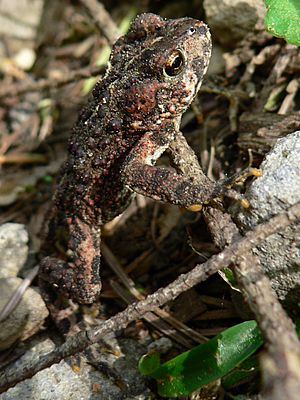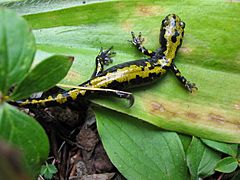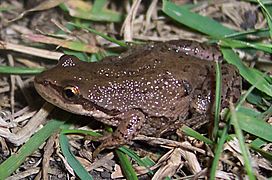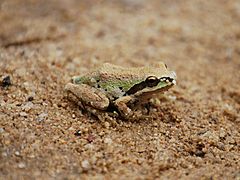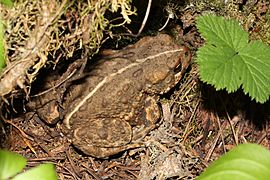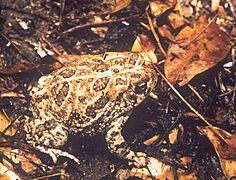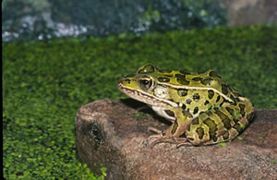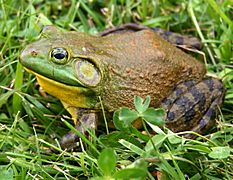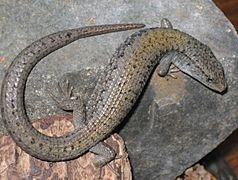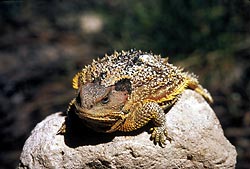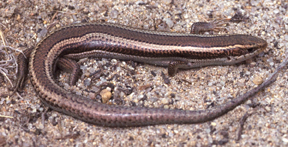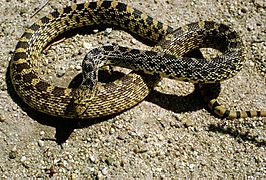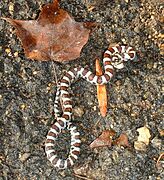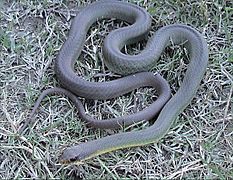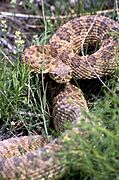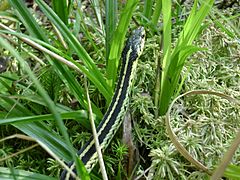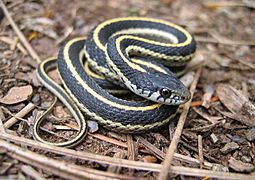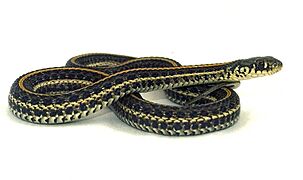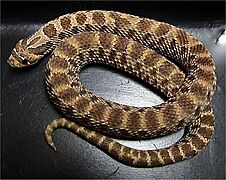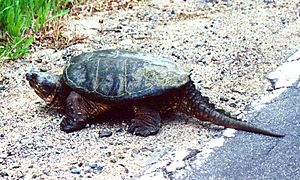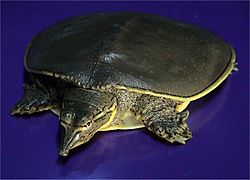List of amphibians and reptiles of Montana facts for kids
Montana is a cool place with lots of different animals! It's home to 14 kinds of amphibians (like frogs and salamanders) and 20 kinds of reptiles (like snakes and lizards). Good news: none of these species are currently in danger of disappearing. However, some are watched closely by the Montana Department of Fish, Wildlife and Parks as "species of concern." This means they might need extra help to stay healthy in the future.
Contents
- Amazing Amphibians of Montana
- What are Tiger Salamanders Like?
- Long-toed Salamanders: Tiny Toes and Cool Habits
- Idaho Giant Salamander: A Big Hunter
- Coeur d'Alene Salamander: A Mountain Dweller
- Boreal Chorus Frog: A Tiny Croaker
- Pacific Tree Frog: A Color Changer
- Plains Spadefoot Toad: A Digging Expert
- Rocky Mountain Tailed Frog: A Unique Tail
- Western Toad: A Large Montana Toad
- Woodhouse's Toad: A Common Friend
- Great Plains Toad: A Loud Singer
- Columbia Spotted Frog: A Water Lover
- Northern Leopard Frog: A Spotted Jumper
- Cool Reptiles of Montana
- Northern Alligator Lizard: A Scaly Friend
- Sagebrush Lizard: A Spiny Desert Dweller
- Greater Short-horned Lizard: The Horned Hunter
- Western Fence Lizard: The Blue-Belly
- Western Skink: A Secretive Sunbather
- Gophersnake: A Big Non-Venomous Snake
- Milk Snake: A Colorful Mimic
- Prairie Rattlesnake: Montana's Only Venomous Snake
- Rubber Boa: A Unique Boa
- Plains Garter Snake: A Striped Snake
- Common Garter Snake: A Diurnal Hunter
- Terrestrial Garter Snake: A Water-Loving Snake
- Eastern Racer: A Fast Snake
- Smooth Greensnake: A Green Grass Snake
- Western Hognose Snake: The Snouted Digger
- Painted Turtle: A Colorful Shell
- Snapping Turtle: A Strong Bite
- Spiny Softshell: A Unique Shell
- Exotic, Non-Native Species
- See also
Amazing Amphibians of Montana
What are Tiger Salamanders Like?
The tiger salamander (Ambystoma tigrinum) is a large salamander. They usually grow to be 6–8 inches long. Some can even reach up to 14 inches! Adults often have blotchy gray, green, or black skin. They have big eyes with eyelids, short snouts, and strong legs.
Tiger salamanders mostly eat small insects and worms. Sometimes, bigger ones might even eat small frogs or baby mice. In Montana, you can find them in many different places east of the continental divide. They like to breed in ponds and lakes that don't have fish.
Long-toed Salamanders: Tiny Toes and Cool Habits
The long-toed salamander (Ambystoma macrodactylum) is a smaller salamander. They are usually 1.5 to 3.5 inches long when they are grown. They have black, brown, and yellow spots. A special feature is their long fourth toe on their back feet!
These salamanders live in western Montana all year. They can be found in many places, from forests to plains. During cold winters, they hibernate (sleep deeply). They use energy stored in their skin and tail to survive.
Idaho Giant Salamander: A Big Hunter
The Idaho giant salamander (Dicamptodon aterrimus) is one of the largest salamanders. They are usually 7 to 11.75 inches long, but can be up to 13 inches. They are dark in color, with shades of brown, purple, tan, gray, and copper. They are strong hunters.
These salamanders have thick heads and bodies. They also have a unique fourth toe on their hind foot with only three parts. You can find them in forested areas in Idaho and in two spots in Mineral County, Montana.
Coeur d'Alene Salamander: A Mountain Dweller
The Coeur d'Alene salamander (Plethodon idahoensis) is a type of woodland salamander. It's a "lungless" salamander, meaning it breathes through its skin! Most of these salamanders live in northern Idaho.
However, some have been seen in western Montana, right along the Idaho border. Scientists are still learning about how many of these salamanders there are.
Boreal Chorus Frog: A Tiny Croaker
The boreal chorus frog (Pseudacris maculata) is a small frog, only about 1.2 inches long. They are usually brown, but can be green. They have three broken stripes on their back. A dark stripe goes from their snout, through their eye, and down their side.
These frogs have slightly bigger toe pads to help them climb plants. In Montana, they are common east of the continental divide. They live in wet meadows and forests near water. They lay their eggs in quiet water, attached to plants.
Pacific Tree Frog: A Color Changer
The Pacific tree frog (Pseudacris regilla) is a very common frog. They live along the West Coast, from California up to Canada. They can live from sea level up to over 10,000 feet high! These frogs can be green or brown. They can even change their color!
They live in many different places and lay their eggs in water. In Montana, this frog is common east of the continental divide.
Plains Spadefoot Toad: A Digging Expert
The plains spadefoot toad (Spea bombifrons) gets its name from a special "spade" on its back legs. This spade helps them dig into sandy soil. They are usually 1.5 to 2.5 inches long. They have a round body and short legs.
Their color can be gray or brown, often matching the soil where they live. In Montana, you can find this toad in the eastern plains, east of the continental divide.
Rocky Mountain Tailed Frog: A Unique Tail
The Rocky Mountain tailed frog (Ascaphus montanus) is a special frog. The "tail" on the male frog is actually part of its body used for reproduction. This "tail" helps them live in fast-flowing streams. It's the only frog in North America that fertilizes eggs internally.
You can find this frog along cold mountain streams in Western Montana.
Western Toad: A Large Montana Toad
The western toad or boreal toad (Bufo boreas) is a large toad. They are usually 2 to 5 inches long. They have a white or cream stripe down their back. Their skin is often dusky gray or greenish with dark spots.
In Montana, this toad lives in the western part of the state.
Woodhouse's Toad: A Common Friend
The Woodhouse's toad (Bufo woodhousii) is a medium-sized toad, about 4 inches long. It's a "true toad" found in the United States and Mexico. Sometimes, these toads can mix with other toad species where their homes overlap.
In Montana, this toad is found in the eastern half of the state.
Great Plains Toad: A Loud Singer
The Great Plains toad (Bufo cognatus) is a fairly large toad. They can be 2 to 4.5 inches long. They are gray, brown, and green with darker spots. Their main food is different kinds of worms.
They like grassy areas with loose soil, which is easy to dig into. They often come out after heavy rain. They have a very loud, harsh call! In Montana, this toad lives in the eastern half of the state.
Columbia Spotted Frog: A Water Lover
The Columbia spotted frog (Rana luteiventris) is a medium-sized frog. It can grow up to 3.5 inches long. Its color ranges from dark green to light brown. It has black spots on its back and legs, which gives it its name.
These frogs spend most of their time in the water. They have more webbing on their back feet than other frogs, which helps them swim. In Montana, this frog is common in the western part of the state. You can find them in or near rivers, streams, lakes, and ponds. They lay their eggs in quiet water.
Northern Leopard Frog: A Spotted Jumper
The northern leopard frog (Rana pipiens) is a large frog, growing up to about 4 inches long. They can be green or brown. They have big, dark, round spots on their back, sides, and legs, like a leopard!
These frogs live in many places, including ponds, swamps, and slow-moving streams. They like water with lots of plants. They can live in cold places, even high up in the mountains.
Cool Reptiles of Montana
Northern Alligator Lizard: A Scaly Friend
The northern alligator lizard (Elgaria coerulea) is a medium-sized lizard. Adults are about 10 inches long, including their tail. They have brownish skin, often with dark spots or bands. They have a special skin fold on their sides.
You can find these lizards in the Rocky Mountains, including western Montana.
Sagebrush Lizard: A Spiny Desert Dweller
The sagebrush lizard (Sceloporus graciosus graciosus) is a common lizard in the western United States. It's named after the sagebrush plants where it often lives. This lizard has spiny scales on its back.
In Montana, you can find this lizard in the southeast part of the state.
Greater Short-horned Lizard: The Horned Hunter
The mountain short-horned lizard (Phrynosoma hernandesi) is a lizard that is active during the day. It mostly eats ants, but can also eat young snakes. These lizards are found in mountain ranges across the western U.S. and into Canada.
They can live from sea level up to over 10,000 feet high!
Western Fence Lizard: The Blue-Belly
The western fence lizard (Sceloporus occidentalis) is a common lizard. It's also called the "blue-belly" because adult males often have blue patches on their bellies. Younger lizards have sand-colored bellies.
These lizards like many different places, like grasslands, forests, and even farms. They usually avoid harsh deserts. There's a small group of these lizards in Sanders County, Montana.
Western Skink: A Secretive Sunbather
The western skink (Eumeces skiltonianus) is a small lizard with smooth scales. They are about 4 to 8 inches long. Western skinks are very good at adapting to different places. They spend a lot of time basking in the sun.
Their diet includes spiders and beetles. If you try to grab them, they might bite! In Montana, you can find this skink in the far northwestern part of the state.
Gophersnake: A Big Non-Venomous Snake
The gophersnake or bullsnake (Pituophis catenifer sayi) is a large snake. It is not venomous. It is very common and found all over Montana. This snake is widespread in the central United States, northern Mexico, and southern Canada.
Milk Snake: A Colorful Mimic
The milk snake (Lampropeltis triangulum) is a type of kingsnake. There are many different kinds of milk snakes, and they can look very different from each other. They can grow from 20 to 60 inches long.
In Montana, the milk snake is found in the central and southeast parts of the state.
Prairie Rattlesnake: Montana's Only Venomous Snake
The prairie rattlesnake (Crotalus viridis viridis) is a venomous snake. It is the only venomous snake found in Montana. It is common and widespread across the state. These snakes live in the western United States, southwestern Canada, and northern Mexico.
Rubber Boa: A Unique Boa
The rubber boa (Charina bottae) is a snake from the boa family. Boas are non-venomous snakes. The rubber boa is one of four species in its group. In Montana, this boa is found in the western and southwestern parts of the state.
Plains Garter Snake: A Striped Snake
The plains garter snake (Thamnophis radix) is a type of garter snake. It has a bright orange or yellow stripe that runs from its head to its tail. The rest of its body is usually gray-green.
You can often find this snake near water, like streams and ponds. It can also live in cities.
Common Garter Snake: A Diurnal Hunter
The valley garter snake (Thamnophis sirtalis fitchi) is a type of common garter snake. Most garter snakes have yellow stripes on a brown background. They are usually 3 to 5 feet long.
The common garter snake is active during the day. In summer, it's most active in the morning and late afternoon. In cooler weather, it prefers the warm afternoons.
Terrestrial Garter Snake: A Water-Loving Snake
The wandering garter snake (Thamnophis elegans vagrans) is a type of western terrestrial garter snake. Most of these snakes have a yellow, light orange, or white stripe down their back. They might also have red or black spots.
This snake often lives in forests and likes to be near water.
Eastern Racer: A Fast Snake
The eastern racer (Coluber constrictor) is a non-venomous snake. They are usually about 3.5 feet long, but some can reach 6 feet! Their colors can vary a lot, depending on where they live. They might be black, brown, blue, or green.
These fast snakes are found all over Montana.
Smooth Greensnake: A Green Grass Snake
The smooth green snake (Opheodrys vernalis) is a non-venomous snake. It's sometimes called a grass snake. This snake is bright green. You can find it mainly in wet meadows, prairies, and clearings in forests.
They mostly eat insects, like crickets, grasshoppers, and caterpillars.
Western Hognose Snake: The Snouted Digger
The western hognose snake (Heterodon nasicus) is a harmless snake. It's light sandy brown with darker brown or gray spots. They have a unique snout that turns upwards, which helps them dig in the soil.
They are quite thick for their size. Females are usually larger than males, growing from 15 to 33 inches long. They are not considered dangerous to humans.
Painted Turtle: A Colorful Shell
The painted turtle (Chrysemys picta) is a small turtle. It's usually 4 to 10 inches long and weighs about 1 to 1.5 pounds. Females are bigger than males. They have a smooth, flat, oval shell that is black to olive.
One special thing about this turtle is the red, orange, or yellow patterns on its legs, tail, neck, and face, like it's been painted!
Snapping Turtle: A Strong Bite
The common snapping turtle (Chelydra serpentina) is a large freshwater turtle. It has a very strong bite! Its natural home stretches from Canada, through the United States, and down to Ecuador.
These turtles are often just called "snappers."
Spiny Softshell: A Unique Shell
The spiny softshell turtle (Apalone spinifera) is one of the largest freshwater turtles in North America. They get their name from the spiny, cone-like bumps on the front edge of their shell. These bumps are not like regular scales.
The spiny softshell turtle lives in many parts of the United States, Canada, and Mexico.
Exotic, Non-Native Species
American Bullfrog: A Large Water Frog
The American bullfrog (Rana catesbeiana) is a very large frog. It's a "true frog" that comes from North America. These frogs like big, permanent water bodies like swamps, ponds, and lakes. You'll usually find them right at the water's edge.
Red-eared Slider: A Popular Pet
The red-eared slider (Trachemys scripta elegans) is a turtle that lives partly in water. It comes from the southern United States. However, it has become common in many other parts of the world because people keep them as pets. They are very popular pets in many countries.
See also


